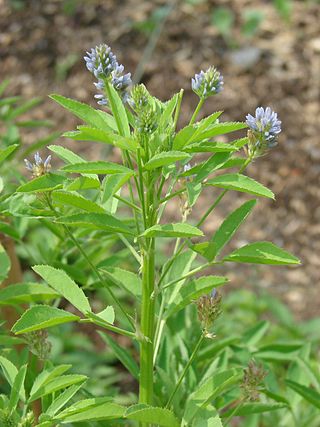
Bellis perennis, the daisy, is a European species of the family Asteraceae, often considered the archetypal species of the name daisy. To distinguish this species from other plants known as daisies, it is sometimes qualified as common daisy, lawn daisy or English daisy.

Taxodium distichum is a deciduous conifer in the family Cupressaceae. It is native to the southeastern United States. Hardy and tough, this tree adapts to a wide range of soil types, whether wet, salty, dry, or swampy. It is noted for the russet-red fall color of its lacy needles.

Lithospermum is a genus of plants belonging to the family Boraginaceae. The genus is distributed nearly worldwide, but most are native to the Americas and the center of diversity is in the southwestern United States and Mexico. Species are known generally as gromwells or stoneseeds.

Spartium junceum, known as Spanish broom, rush broom, or weaver's broom, it is a species of flowering plant in the family Fabaceae and the sole species in the genus Spartium. It is closely related to the other brooms.

Aesculus californica, commonly known as the California buckeye or California horse-chestnut, is a species of buckeye native to California and southwestern Oregon.

Lavandula angustifolia, formerly L. officinalis, is a flowering plant in the family Lamiaceae, native to the Mediterranean. Its common names include lavender, true lavender and English lavender ; also garden lavender, common lavender and narrow-leaved lavender.

Lithospermum arvense, known as field gromwell, corn gromwell, bastard alkanet, and stone seed, is a flowering plant of the family Boraginaceae. It is native to Europe and Asia, as far north as Korea, Japan and Russia, and as far south as Afghanistan and northern Pakistan. [1] It is known in other places as an introduced species, including much of North America and Australia. [2],[3] The European Union has granted the refined oil of the seed of Buglossoides arvensis novel food status and some farmers are growing it [4] commercially in the United Kingdom as a plant-variety patented (PVP) and trademarked cultivar (Ahiflower®). The seed oil contains high levels (63-72%) of omega-3 ALA (c18:3), omega-3 SDA (c18:4), and omega-6 GLA (c18:3)[5] and has GRAS review status from the US Food and Drug Administration, Canadian ingredient master file (IMF) registration and novel food status, and GMP+ Feed Support Product status in the EU for livestock and companion animals. The seed oil also has TGA Australia Complementary Medicines approval status, ANVISA/MAPA Brazil human and animal alimentary use approval, and limited food use approvals in Korea and Japan.

Lithospermum officinale, or common gromwell or European stoneseed, is a flowering plant species in the family Boraginaceae, native to Eurasia. It is the host plant for caterpillars of the monophagous moth Ethmia dodecea.

Glandora diffusa, the purple gromwell, syn. Lithodora diffusa, Lithospermum diffusa, is a species of flowering plant in the family Boraginaceae. It is a mat-forming perennial growing to 15 cm (6 in) tall by 60 cm (24 in) or more wide, with dark green, hairy evergreen leaves and masses of blue or white 5-lobed flowers. It is suitable for cultivation in a rock garden or alpine garden.

Lithospermum canescens, or the hoary puccoon is a perennial herb endemic to eastern North America. The plant grows in a variety of habitats. It has golden yellow flowers which bloom from April to May.

Malus baccata is an Asian species of apple known by the common names Siberian crab apple, Siberian crab, Manchurian crab apple and Chinese crab apple. It is native to many parts of Asia, but is also grown elsewhere as an ornamental tree and for rootstock. It is used for bonsai. It bears plentiful, fragrant, white flowers and edible red to yellow fruit of about 1 cm diameter.

Lithospermum ruderale is a species of flowering plant in the borage family known by the common name western stoneseed or lemonweed. It is native to western Canada and the western United States, where it can be found in many types of habitat. A perennial herb growing from a taproot and woody caudex, it is covered with fine, more or less upright, hairs, especially on the stems. It produces a cluster of erect leafy stems ranging from 20 to 50 centimetres centimeters in height. The stems support lance-shaped leaves ranging from 2.5–10 cm (1–4 in) in length. Bunches of flowers with leaf-like bracts appear toward the top of the stem amongst the leaves. The corolla is fused at the base with five lobes which are light yellow, often slightly greenish, and about a centimeter long and wide. The style is short. The fruit consists of one or two, sometimes four, clustered glossy grey nutlets, 3.5 to 6, sometimes as much as 8 mm long.

Salvia subincisa, the sawtooth sage or sharptooth sage, is a small erect Salvia species that is native to New Mexico, Arizona, and Texas in the United States, and the Baja California peninsula, Chihuahua, and Sonora in Mexico. It is typically found growing in sandy areas near roadsides or other arid parts of the American southwest. It is very often associated with Pueblo ruins in New Mexico, along with Cleome serrulata and Lithospermum caroliniense.

Trigonella caerulea is an annual herb in the family Fabaceae. It is 30–60 cm tall. Its leaves are obovate or lance-shaped, 2–5 cm long, 1–2 cm wide and saw-toothed in upper part. Its flower stalks are compact, globular racemes, longer than the leaves. The sepals are twice as short as the corolla, its teeth are equal to the tube. The corolla is 5.5-6.5 mm long and blue. The pods are erect or slightly curved, compressed, 4–5 mm long with beak 2 mm. The seeds are small and elongated. It blossoms in April–May, the seeds ripen in May–June. It is self-pollinated.

Lithospermum latifolium is a species of flowering plant in the borage family known by the common names American gromwell and American stoneseed. Its native range is centered in the Midwestern United States, where it is found in calcareous forests. It is a hairy, tall perennial herb that produces small yellow flowers in late spring.

Lithospermum erythrorhizon, commonly called purple gromwell, red stoneroot, red gromwell, red-root gromwell and redroot lithospermum, is a plant species in the family Boraginaceae. It is called zǐcǎo (紫草) in Chinese, jichi (지치) in Korean, and murasaki in Japanese.

Lithospermum molle, the softhair marbleseed, is a species of flowering plant in the forget-me-not family. This species is a narrow endemic, native primarily to the Nashville Basin of Tennessee, where it is found in limestone prairies near cedar glades. There are disjunct populations in similar habitats in the Ozark Mountains of Missouri, in northwest Alabama, in Logan and Warren County, Kentucky as well as other small areas of Tennessee. Outside of Tennessee, it is very rare and perhaps no longer exists in Alabama and Kentucky due to habitat destruction. Because of its highly restricted geographic range, this species is considered vulnerable.

Lithospermum tuberosum, commonly called the southern stoneseed or tuberous stoneseed, is a species of flowering plant in the forget-me-not family. It is native to the Southeastern United States, where it is found in calcareous woodlands.

Lithospermum parviflorum, commonly called Eastern Prairie Marbleseed, is a species of flowering plant in the forget-me-not family. It is native to the eastern North America.



















